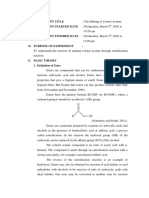Esters
Esters
Uploaded by
Nevin BakrCopyright:
Available Formats
Esters
Esters
Uploaded by
Nevin BakrOriginal Description:
Copyright
Available Formats
Share this document
Did you find this document useful?
Is this content inappropriate?
Copyright:
Available Formats
Esters
Esters
Uploaded by
Nevin BakrCopyright:
Available Formats
Esters are chemical compounds consisting of a carbonyl adjacent to an ether linkage.
They are derived by reacting an oxoacid with a hydroxyl compound such as an alcohol or phenol.[1] Esters are usually derived from an inorganic acid or organic acid in which at least one -OH (hydroxyl) group is replaced by an -O-alkyl (alkoxy) group, and most commonly from carboxylic acids and alcohols. That is, esters are formed by condensing an acid with an alcohol. Esters are ubiquitous. Most naturally occurring fats and oils (e.g. triglycerides) are the fatty acid esters of glycerol. Esters with low molecular weight are commonly used as fragrances and found in essential oils and pheromones. Phosphoesters form the backbone of DNA molecules. Nitrate esters, such as nitroglycerin, are known for their explosive properties, while polyesters are important plastics, with monomers linked by ester moieties.
Contents
1 Nomenclature o 1.1 Etymology o 1.2 IUPAC nomenclature of Esters o 1.3 Orthoesters o 1.4 "Inorganic esters" 2 Structure and bonding 3 Physical properties and characterization o 3.1 Characterization and analysis 4 Applications and occurrence 5 Preparation o 5.1 Esterification of carboxylic acids o 5.2 Alcoholysis of acyl chlorides and acid anhydrides o 5.3 Alkylation of carboxylate salts o 5.4 Transesterification o 5.5 Carbonylation o 5.6 Addition of carboxylic acids to alkenes o 5.7 Other methods 6 Reactions o 6.1 Addition of nucleophiles at carbonyl o 6.2 Reduction o 6.3 Claisen condensation and related reactions o 6.4 Other reactions o 6.5 Protecting groups 7 List of ester odorants 8 See also 9 References 10 External links
Nomenclature
Etymology
The word 'ester' was coined in 1848 by German chemist Leopold Gmelin,[2] probably as a contraction of the German Essigther - acetic ether.
IUPAC nomenclature of Esters
Main article: IUPAC nomenclature of organic chemistry#Esters Ester names are derived from the parent alcohol and the parent acid, where the latter may be an organic or an inorganic acid. Esters derived from the simplest carboxylic acids are commonly named according to the more traditional, so-called "trivial names" e.g. as formate, acetate, propionate, and butyrate, as opposed to the IUPAC nomenclature methanoate, ethanoate, propanoate and butanoate. Esters derived from more complex carboxylic acids are, on the other hand, more frequently named using the systematic IUPAC name, based on the name for the acid followed by the suffix oate. For example the ester hexyl octanoate, also known under the trivial name hexyl caprylate, has the formula CH3(CH2)6CO2(CH2)5CH3.
Ethyl acetate derived from an alcohol (blue) and an acyl group (yellow) derived from a carboxylic acid. The chemical formulas of organic esters are typically written in the format of RCO2R', where R and R' are the hydrocarbon parts of the carboxylic acid and alcohol, respectively. For example butyl acetate (systematically butyl ethanoate), derived from butanol and acetic acid (systematically ethanoic acid) would be written CH3CO2C4H9. Alternative presentations are common including BuOAc and CH3COOC4H9. Cyclic esters are called lactones, regardless of whether they are derived from an organic or an inorganic acid. One example of a (organic) lactone is gammavalerolactone.
Orthoesters
An uncommon class of organic esters are the orthoesters, which have the formula RC(OR')3. Triethylorthoformate (HC(OC2H5)3) is derived, in terms of its name (but not its synthesis) from orthoformic acid (HC(OH)3) and ethanol.
"Inorganic esters"
A phosphoric acid ester Ester is a general term for the product derived from the condensation of an acid and an alcohol. Thus, the nomenclature extends to inorganic oxo acids, e.g. phosphoric acid, sulfuric acid, nitric acid and boric acid. For example, triphenyl phosphate is the ester derived from phosphoric acid and phenol. Organic carbonates, such as ethylene carbonate, are derived from carbonic acid and ethylene glycol.
Structure and bonding
Esters contain a carbonyl center, which gives rise to 120C-C-O and O-C-O angles. Unlike amides, esters are structurally flexible functional groups because rotation about the C-O-C bonds has a low barrier. Their flexibility and low polarity is manifested in their physical properties; they tend to be less rigid (lower melting point) and more volatile (lower boiling point) than the corresponding amides.[3] The pKa of the alpha-hydrogens on esters is around 25.[4]
Physical properties and characterization
Esters are more polar than ethers but less polar than alcohols. They participate in hydrogen bonds as hydrogen-bond acceptors, but cannot act as hydrogen-bond donors, unlike their parent alcohols. This ability to participate in hydrogen bonding confers some water-solubility. Because of their lack of hydrogen-bond-donating ability, esters do not self-associate. Consequently esters are more volatile than carboxylic acids of similar molecular weight.[3]
Characterization and analysis
Esters are usually identified by gas chromatography, taking advantage of their volatility. IR spectra for esters feature an intense sharp band in the range 1730 1750 cm1 assigned to C=O. This peak changes depending on the functional groups attached to the carbonyl. For example, a benzene ring or double bond in conjugation with the carbonyl will bring the wavenumber down about 30 cm1.
Applications and occurrence
Esters are widespread in nature and are widely used in industry. In nature, fats are, in general, triesters derived from glycerol and fatty acids.[5] Esters are responsible for the aroma of many fruits, including apples, durians, pears, bananas, pineapples, and strawberries.[6] Several billion kilograms of polyesters are produced industrially annually, important products being polyethylene terephthalate, acrylate esters, and cellulose acetate.[7]
Representative triglyceride found in a linseed oil, a triester (triglyceride) derived of linoleic acid, alpha-linolenic acid, and oleic acid.
Preparation
Esterification is the general name for a chemical reaction in which two reactants (typically an alcohol and an acid) form an ester as the reaction product. Esters are common in organic chemistry and biological materials, and often have a characteristic pleasant, fruity odor. This leads to their extensive use in the fragrance and flavor industry. Ester bonds are also found in many polymers.
Esterification of carboxylic acids
The classic synthesis is the Fischer esterification, which involves treating a carboxylic acid with an alcohol in the presence of a dehydrating agent: RCO2H + R'OH RCO2R' + H2O
The equilibrium constant for such reactions is about 5 for typical esters, e.g., ethyl acetate.[8] The reaction is slow in the absence of a catalyst. Sulfuric acid is a typical catalyst for this reaction. Many other acids are also used such as polymeric sulfonic acids. Since esterification is highly reversible, the yield of the ester can be improved using Le Chatelier's principle:
using the alcohol in large excess (i.e., as a solvent) using a dehydrating agent: sulfuric acid not only catalyzes the reaction but sequesters water (a reaction product). Other drying agents such as molecular sieves are also effective. removal of water by physical means such as distillation as a low-boiling azeotropes with toluene, in conjunction with a Dean-Stark apparatus.
Reagents are known that drive the dehydration of mixtures of alcohols and carboxylic acids. One example is the Steglich esterification, which is a method of forming esters under mild conditions. The method is popular in peptide synthesis, where the substrates are sensitive to harsh conditions like high heat. DCC
(dicyclohexylcarbodiimide) is used to activate the carboxylic acid to further reaction. DMAP (4-dimethylaminopyridine) is used as an acyl-transfer catalyst.[9]
You might also like
- Eddycurrent Testing Level 1 PDFDocument62 pagesEddycurrent Testing Level 1 PDFgofardrajad100% (2)
- A 1Document29 pagesA 1Christopher WilliamsNo ratings yet
- Ester: For Other Uses, SeeDocument15 pagesEster: For Other Uses, SeemeritnasaNo ratings yet
- EsterificareaDocument43 pagesEsterificareaMahagney SalehNo ratings yet
- ESTERSDocument36 pagesESTERSAbdihakemNo ratings yet
- Ester GroupDocument3 pagesEster GroupAnubhav SwaroopNo ratings yet
- EsterDocument2 pagesEsterCyrisse MONTANONo ratings yet
- Science Ester Info 1Document10 pagesScience Ester Info 1Albert AntonioNo ratings yet
- EsterDocument13 pagesEsterdearbhupiNo ratings yet
- Toluenesulfonic Acid: Preparation and HandlingDocument2 pagesToluenesulfonic Acid: Preparation and HandlingMashudi FikriNo ratings yet
- G6 Alcohols Phenols and EthersDocument64 pagesG6 Alcohols Phenols and EthersHarijaNo ratings yet
- EstersDocument3 pagesEstersmohammadrefaat26No ratings yet
- Structure of A Carboxylic AcidDocument7 pagesStructure of A Carboxylic AcidKajal SinghNo ratings yet
- Ether: Navigation Search AetherDocument7 pagesEther: Navigation Search AetherMuhammad Wahyu Nugraha0% (1)
- 5 Hydrocarbon Derivatives 2Document28 pages5 Hydrocarbon Derivatives 2Marivic TayabanNo ratings yet
- Carboxylic Acid: From Wikipedia, The Free EncyclopediaDocument11 pagesCarboxylic Acid: From Wikipedia, The Free EncyclopediaDipti BagdeNo ratings yet
- Chemistry Investigatory ProjectDocument11 pagesChemistry Investigatory ProjectDeepa SinghNo ratings yet
- Bautista, John Mhar M. (Experiment 7)Document4 pagesBautista, John Mhar M. (Experiment 7)2g8vdspqm5No ratings yet
- IntroductionDocument16 pagesIntroductionAkhtar RazaNo ratings yet
- I. Experiment Title: Aldehyde, Ketone and Carboxylic AcidDocument10 pagesI. Experiment Title: Aldehyde, Ketone and Carboxylic AcidLaily SafitriNo ratings yet
- EsterificationDocument3 pagesEsterificationKhris Sy-HandumonNo ratings yet
- Las 8Document6 pagesLas 8Carl DoriaNo ratings yet
- Loaded1-Prof - DO.Moronkola-CHE-176-2023-Course Content1Document58 pagesLoaded1-Prof - DO.Moronkola-CHE-176-2023-Course Content1taiwodamola789No ratings yet
- Reactions of AlcoholsDocument3 pagesReactions of AlcoholsKimNo ratings yet
- Carboxylic AcidDocument6 pagesCarboxylic AcidVishu AgrawalNo ratings yet
- Esters Fats and Oils Pupil NotesDocument19 pagesEsters Fats and Oils Pupil NotesMasumNo ratings yet
- Esters75275254 131207020139 Phpapp02Document19 pagesEsters75275254 131207020139 Phpapp02Mujthaba AdmaniNo ratings yet
- Alcohols: Alcohol, Any of A Class ofDocument3 pagesAlcohols: Alcohol, Any of A Class ofCool for the AnimeNo ratings yet
- Alchohol and EterDocument12 pagesAlchohol and EterFaza Afina RizaNo ratings yet
- G2W6 - Alcohols Aldehydes and KetonesDocument12 pagesG2W6 - Alcohols Aldehydes and Ketonesd494z6prkcNo ratings yet
- B. Physical Properties of AlcoholsDocument4 pagesB. Physical Properties of AlcoholsAnjo Pasiolco CanicosaNo ratings yet
- Carboxylic Acid: "COOH" Redirects Here. For The Bulgarian Musician, SeeDocument9 pagesCarboxylic Acid: "COOH" Redirects Here. For The Bulgarian Musician, SeeFighter_ace_97No ratings yet
- Share My Portfolio in Chem 102Document61 pagesShare My Portfolio in Chem 102Remar PabalayNo ratings yet
- Alcohol Alcohol, Any of A Class of Organic CompoundsDocument4 pagesAlcohol Alcohol, Any of A Class of Organic CompoundsJason Orolfo Salvadora HLNo ratings yet
- A. Experiment Title: The Making of N-Butyl Acetate B. Experiment Started Date: Wednesday, March 4Document21 pagesA. Experiment Title: The Making of N-Butyl Acetate B. Experiment Started Date: Wednesday, March 4Era MelaniaNo ratings yet
- Carboxylic AcidDocument13 pagesCarboxylic AcidJeremy NayagamNo ratings yet
- Ester & AmidesDocument13 pagesEster & AmidesMohd NazriNo ratings yet
- Alcohols Phenols and Ether by AarkumarDocument0 pagesAlcohols Phenols and Ether by AarkumarNikhil Surya MukhiNo ratings yet
- Phosphate EstersDocument2 pagesPhosphate EstersNikola TasićNo ratings yet
- LabReport Experiment#5 ParthPatel Copy 2Document7 pagesLabReport Experiment#5 ParthPatel Copy 2parthNo ratings yet
- Ethanoic Acid ChemDocument14 pagesEthanoic Acid ChemjasmynefNo ratings yet
- 4.1.3 Carboxylic Acids & EstersDocument5 pages4.1.3 Carboxylic Acids & EstersFin BrickmanNo ratings yet
- Exp 10Document9 pagesExp 10ChantalDanaNo ratings yet
- Carboxylic Acid 1Document14 pagesCarboxylic Acid 1Junaid KhanNo ratings yet
- AnalysisDocument3 pagesAnalysisMarigold RamirezNo ratings yet
- Explain Chemical Reactions of Alcohol CompoundsDocument2 pagesExplain Chemical Reactions of Alcohol CompoundsIrfan DanialNo ratings yet
- Preparation and Reactions of EthersDocument54 pagesPreparation and Reactions of EthersEj AgsaldaNo ratings yet
- ESTERS 3nd FixedDocument6 pagesESTERS 3nd Fixed陈洁No ratings yet
- Hydrocarbon and Its DerivativesDocument12 pagesHydrocarbon and Its DerivativesReulyn Lardizabal RafaelNo ratings yet
- Bihari INVESTIGATORY PROJECT PDFDocument17 pagesBihari INVESTIGATORY PROJECT PDFDeepa SinghNo ratings yet
- 2019 Ch104 Organic AcidsDocument111 pages2019 Ch104 Organic Acidsgenesis gengerNo ratings yet
- Esters IntroductionDocument6 pagesEsters IntroductionAkshatNo ratings yet
- Alcohol, Phenol, and Ethers:: "Their Structures, Physical Properties and Nomenclature"Document33 pagesAlcohol, Phenol, and Ethers:: "Their Structures, Physical Properties and Nomenclature"AmanNo ratings yet
- CHM 171 Lecture Note Nov 2021Document10 pagesCHM 171 Lecture Note Nov 2021julietjustina14No ratings yet
- Aromatic AcidDocument61 pagesAromatic Acidratanpriya23029No ratings yet
- AldehydeDocument9 pagesAldehydesenkatuukaNo ratings yet
- Chemistry Reference Materials 8 and 9Document47 pagesChemistry Reference Materials 8 and 9Colb MLGNo ratings yet
- Synthesis of Methyl SalicylateDocument2 pagesSynthesis of Methyl SalicylateMich Tolentino0% (1)
- Assignment in Advance Chemistry (Hydrocarbons) : Frauline C. Tadle IV-Galileo Mr. Romel Condeza S.Y.: 2010-2011Document7 pagesAssignment in Advance Chemistry (Hydrocarbons) : Frauline C. Tadle IV-Galileo Mr. Romel Condeza S.Y.: 2010-2011Fraul TadleNo ratings yet
- Biochemistry Applied to Beer Brewing - General Chemistry of the Raw Materials of Malting and BrewingFrom EverandBiochemistry Applied to Beer Brewing - General Chemistry of the Raw Materials of Malting and BrewingRating: 4 out of 5 stars4/5 (1)
- Mold Process Begins by Melting Plastic Into Parisons (Tube-Like FormsDocument1 pageMold Process Begins by Melting Plastic Into Parisons (Tube-Like FormsNevin BakrNo ratings yet
- Mold Process Begins by Melting Plastic Into Parisons (Tube-Like FormsDocument1 pageMold Process Begins by Melting Plastic Into Parisons (Tube-Like FormsNevin BakrNo ratings yet
- Mold Process Begins by Melting Plastic Into Parisons (Tube-Like FormsDocument1 pageMold Process Begins by Melting Plastic Into Parisons (Tube-Like FormsNevin BakrNo ratings yet
- Mold Process Begins by Melting Plastic Into Parisons (Tube-Like FormsDocument1 pageMold Process Begins by Melting Plastic Into Parisons (Tube-Like FormsNevin BakrNo ratings yet
- Single Machines FillingDocument1 pageSingle Machines FillingNevin BakrNo ratings yet
- DisadvantagesDocument1 pageDisadvantagesNevin BakrNo ratings yet
- NetaDocument1 pageNetaNevin BakrNo ratings yet
- Ming Raw Material Then Minimize Those Caused During The Extrusion ProcessDocument1 pageMing Raw Material Then Minimize Those Caused During The Extrusion ProcessNevin BakrNo ratings yet
- Then Minimize Those Caused During The Extrusion Process.: More (+)Document1 pageThen Minimize Those Caused During The Extrusion Process.: More (+)Nevin BakrNo ratings yet
- DisadvantagesDocument1 pageDisadvantagesNevin BakrNo ratings yet
- Material Then Minimize Those Caused During The Extrusion ProcessDocument1 pageMaterial Then Minimize Those Caused During The Extrusion ProcessNevin BakrNo ratings yet
- Specks Are in The Incoming Raw Material Then Minimize Those Caused During The Extrusion ProcessDocument1 pageSpecks Are in The Incoming Raw Material Then Minimize Those Caused During The Extrusion ProcessNevin BakrNo ratings yet
- Are in The Incoming Raw Material Then Minimize Those Caused During The Extrusion ProcessDocument1 pageAre in The Incoming Raw Material Then Minimize Those Caused During The Extrusion ProcessNevin BakrNo ratings yet
- More (+) : The Incoming Raw Material Then Minimize Those Caused During The Extrusion ProcessDocument1 pageMore (+) : The Incoming Raw Material Then Minimize Those Caused During The Extrusion ProcessNevin BakrNo ratings yet
- Figure Ou How Many Specks Are in The Incoming Raw Material Then Minimize Those Caused During The Extrusion ProcessDocument1 pageFigure Ou How Many Specks Are in The Incoming Raw Material Then Minimize Those Caused During The Extrusion ProcessNevin BakrNo ratings yet
- How Many Specks Are in The Incoming Raw Material Then Minimize Those Caused During The Extrusion ProcessDocument1 pageHow Many Specks Are in The Incoming Raw Material Then Minimize Those Caused During The Extrusion ProcessNevin BakrNo ratings yet
- DisadvantagesDocument1 pageDisadvantagesNevin BakrNo ratings yet
- First, Figure Ou How Many Specks Are in The Incoming Raw Material Then Minimize Those Caused During The Extrusion ProcessDocument1 pageFirst, Figure Ou How Many Specks Are in The Incoming Raw Material Then Minimize Those Caused During The Extrusion ProcessNevin BakrNo ratings yet
- First, Figure Out How Many Specks Are in The Incoming Raw Material Then Minimize Those Caused During The Extrusion ProcessDocument1 pageFirst, Figure Out How Many Specks Are in The Incoming Raw Material Then Minimize Those Caused During The Extrusion ProcessNevin BakrNo ratings yet
- DisadvantagesDocument1 pageDisadvantagesNevin BakrNo ratings yet
- DisadvantagesDocument1 pageDisadvantagesNevin BakrNo ratings yet
- DisadvantagesDocument1 pageDisadvantagesNevin BakrNo ratings yet
- VortDocument1 pageVortNevin BakrNo ratings yet
- DisadvantagesDocument1 pageDisadvantagesNevin BakrNo ratings yet
- Concepts and Models of Inorganic Chemistry Douglas Bodie e - CompressDocument1 pageConcepts and Models of Inorganic Chemistry Douglas Bodie e - CompressPriyabrata GhoshNo ratings yet
- Material Science and Engineering: Diffusion Engr. Joseph Benedict N. PrimDocument29 pagesMaterial Science and Engineering: Diffusion Engr. Joseph Benedict N. PrimJOSEPH BENEDICT PRIMNo ratings yet
- ReactionsDocument5 pagesReactionsYeKwon Patrick HuhNo ratings yet
- ISM Chapter 11Document32 pagesISM Chapter 11戴瑋志No ratings yet
- MOLECULAR POLARITY Activity ModuleDocument7 pagesMOLECULAR POLARITY Activity ModuleMaria CongNo ratings yet
- Wave SolderDocument9 pagesWave SolderFredy HandokoNo ratings yet
- Ge Elec 1 Module 2 Lesson 3 AssignmentDocument3 pagesGe Elec 1 Module 2 Lesson 3 AssignmentRucci LucianoNo ratings yet
- CHE 509 - Gravity Separation (Lecture 3)Document55 pagesCHE 509 - Gravity Separation (Lecture 3)Jane Eilyza AballaNo ratings yet
- Proficiency Testing Program Registration Application PreviewDocument4 pagesProficiency Testing Program Registration Application PreviewShiv PandeyNo ratings yet
- General Chemistry Module 6Document15 pagesGeneral Chemistry Module 6Junelle Ramos Aquino60% (5)
- 13.periodic Table and Periodicity PDFDocument20 pages13.periodic Table and Periodicity PDFP. E. I. AcademicsNo ratings yet
- B Thermal PhysicsDocument16 pagesB Thermal PhysicsTravis TeohNo ratings yet
- Mec281: Materials Science: Phase DiagramDocument74 pagesMec281: Materials Science: Phase Diagrampatel ketan100% (1)
- 13-2 The Oscillating Clock Reaction orDocument3 pages13-2 The Oscillating Clock Reaction oraryopoorNo ratings yet
- Thomas-Fermi Screening by Lindhard FormulaDocument7 pagesThomas-Fermi Screening by Lindhard FormuladanqphyNo ratings yet
- Final Answer Key-WebsiteDocument6 pagesFinal Answer Key-Websiteapi-292258241No ratings yet
- Wrought Dental Alloys and Dental WireDocument14 pagesWrought Dental Alloys and Dental WireJu Ju WareeratNo ratings yet
- Potential of CNG As A Fuel For VehiclesDocument66 pagesPotential of CNG As A Fuel For VehiclesSk Khasim100% (1)
- Natural PH Indicator From Tapioca StarchCurcumin FilmDocument7 pagesNatural PH Indicator From Tapioca StarchCurcumin FilmKhaznah Khalishah HidayatNo ratings yet
- FEA and Experimental Analysis of Honeycomb Sandwich Panel Using Glass FiberDocument8 pagesFEA and Experimental Analysis of Honeycomb Sandwich Panel Using Glass FiberInternational Journal of Application or Innovation in Engineering & ManagementNo ratings yet
- Number Name Description Halal StatusDocument16 pagesNumber Name Description Halal Statuszohaib_farooqNo ratings yet
- VSEPR-Shapes-of-Molecules - Illustrated Graphic PDFDocument1 pageVSEPR-Shapes-of-Molecules - Illustrated Graphic PDFSandeep JainNo ratings yet
- IrigasiDocument21 pagesIrigasiFatimah DewiNo ratings yet
- 9.2 Quantum Theory and The AtomDocument31 pages9.2 Quantum Theory and The AtomRyuusukeNo ratings yet
- Stainless Steels For High Service Temperatures: Outokumpu Therma RangeDocument12 pagesStainless Steels For High Service Temperatures: Outokumpu Therma RangeAngel MendozaNo ratings yet
- Thermodynamic Quantities For Selected Substances AT: AppendixDocument3 pagesThermodynamic Quantities For Selected Substances AT: AppendixSudibyo GunawanNo ratings yet
- Chapter Two Hyd-WPS Office-1Document9 pagesChapter Two Hyd-WPS Office-1Faraz AliNo ratings yet
- Mineaturization Concepts, Benefits and Materials For MEMSDocument48 pagesMineaturization Concepts, Benefits and Materials For MEMSVaibhav RanaNo ratings yet
- Determination of Na, K, CA and MG in Xanthan Gum Sample Treatment by Acid DigestionDocument6 pagesDetermination of Na, K, CA and MG in Xanthan Gum Sample Treatment by Acid DigestionSorin LazarNo ratings yet

















































































































